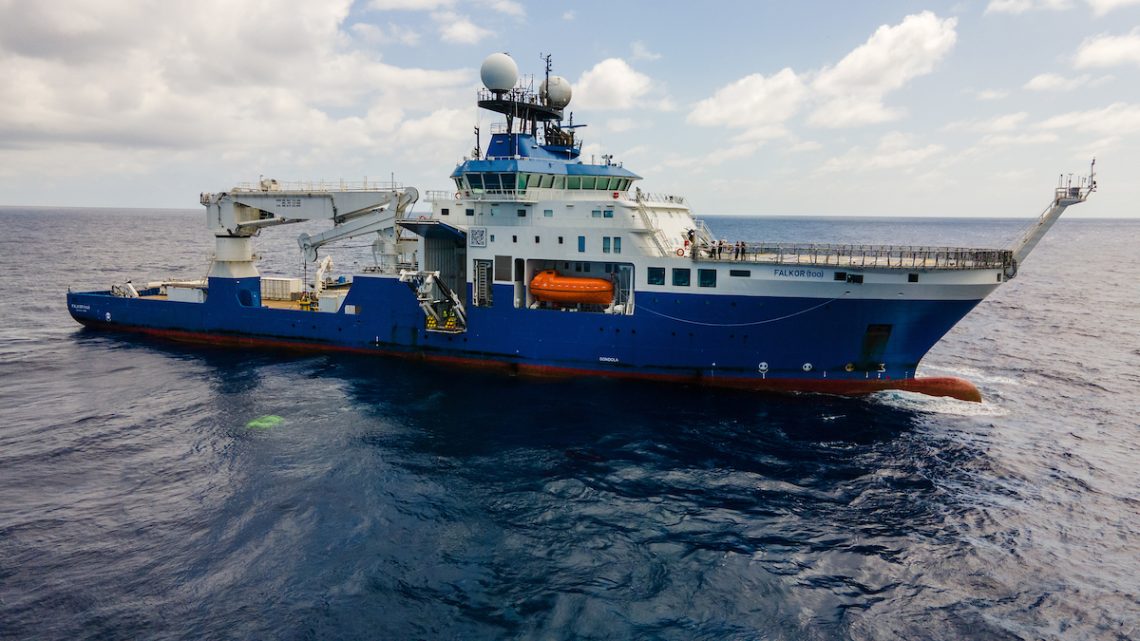Silhouetted in front of a map of Puerto Rico, Santiago Herrera (Principal Investigator, Lehigh University) gives a seminar to scientists and crew to familiarise them with the subject matter of the cruise.
Tallest of underwater features discovered by crew of research vessel Falkor (too) stands over 1.5 miles high
The crew of Schmidt Ocean Institute’s research vessel Falkor (too) discovered four underwater mountains — the tallest of which is over 1.5 miles high — on a January transit from Golfito, Costa Rica, to Valparaiso, Chile, the organization announced today.
The new seamounts, which range in size from approximately 1,591 meters (5,220 feet) to 2,681 meters (8,796 feet), add to the crew’s discovery last November of an underwater mountain that was twice the height of the Burj Khalifa at 1,600 meters (5,259 feet) in international waters off Guatemala.
The
largest of the four seamounts recently discovered by Schmidt Ocean
Institute experts is 2,681 meters tall, covers 450 square kilometers,
and sits 1,150 meters below the surface.
It was discovered during a mapping transit from Costa Rica to Chile in January 2024.
Using multibeam mapping, Schmidt Ocean Institute’s marine technicians and trained hydrographic experts, John Fulmer and Tomer Ketter, confirmed that the seafloor features had not been previously included in any bathymetric database.
The seamounts were found as the technicians plotted a course to examine gravity anomalies during the transit from Costa Rica to Chile.
Changes in the shape of the seafloor appear as very slight shifts in the Ocean surface; a deep trench will cause a slight depression, and a mountain can create an almost imperceptible bump on top of the Ocean. These subtle clues can help experts make discoveries and create better, more detailed maps of the seafloor.
“We were fortunate enough to be able to plan an opportunistic mapping route using these gravity anomalies in satellite altimetry data,” said Fulmer.
“We were fortunate enough to be able to plan an opportunistic mapping route using these gravity anomalies in satellite altimetry data,” said Fulmer.
Eulogio Soto (Scientist, Universidad de Valparaíso) and his colleagues work on sediment cores in the Dirty Wet Lab while images of multibeam sonar readings of the seafloor below them are rendered on nearby monitors.
“Examining gravity anomalies is a fancy way of saying we looked for bumps on a map, and when we did, we located these very large seamounts while staying on schedule for our first science expedition in Chile at the start of this year.”
Whenever sea conditions permit, the crew collects mapping data as the research vessel moves, or transits, from one location to another.
Since 2012, scientists on Schmidt Ocean Institute’s research vessels Falkor and Falkor (too) have mapped about 1.5 million square kilometers and discovered 29 seamounts, hills, and trenches.
Underwater mountains and trenches often host deep-sea coral reefs, sponges, and anemones living alongside organisms that find food, shelter, and a rocky surface to cling to along mountain slopes.
 Research vessel Falkor (too) photographed during an expedition that tested new high-resolution mapping methods. Seafloor mapping is integral to oceanographic research.
Research vessel Falkor (too) photographed during an expedition that tested new high-resolution mapping methods. Seafloor mapping is integral to oceanographic research.Bathymetric data illustrates the seafloor’s depth, contours, and physical features.
“A map is a fundamental tool for understanding our planet — locating seamounts almost always leads us to understudied biodiversity hotspots,” said Dr. Jyotika Virmani, executive director of Schmidt Ocean Institute.
“Every time we find these bustling seafloor communities, we make incredible new discoveries and advance our knowledge of life on Earth.”
STRM bathymetry off of Peru coast via the GeoGarage platform
The absence of detailed underwater topography, or bathymetric data, hinders the ability to manage marine resources sustainably, safely navigate vessels at sea, and safeguard coastal communities. Schmidt Ocean Institute is a partner of The Nippon Foundation-GEBCO Seabed 2030 Project – an ambitious effort accelerating ocean mapping efforts and working towards mapping the entire seafloor by 2030.
“These incredible discoveries by Schmidt Ocean Institute underscore the importance of a complete map of the seabed in our quest for understanding Earth’s final frontier,” said Jamie McMichael-Phillips, project director of Seabed 2030.
“These incredible discoveries by Schmidt Ocean Institute underscore the importance of a complete map of the seabed in our quest for understanding Earth’s final frontier,” said Jamie McMichael-Phillips, project director of Seabed 2030.
“With 75 percent of the ocean still to be mapped, there is much to be uncovered. Ocean mapping is crucial to our understanding of the planet and, in turn, our ability to ensure its protection and sustainable management.”
Links :
- LiveScience : City-size seamount triple the height of world's tallest building discovered via gravitational anomalies
- Hydro : Research vessel finds four new seamounts in high seas
- New Scientist : Enormous underwater mountains discovered off west coast of Americas
- Maritime Executive : Independent Researchers Reveal Four Unknown Seamounts
- Science Alert : Almost 20,000 Ancient Volcanoes Discovered at The Bottom of The Ocean
- AGU : Global Distribution and Morphology of Small Seamounts
- EOS : Subducted Seamounts May Lead to Larger Earthquakes
- GeoGarage blog : Massive new seamount discovered in international waters ...





No comments:
Post a Comment